PROJECT: SecureIT
This document outlines my contributions to the project SecureIT.
Overview
With the increasing digitisation of all businesses, managing one’s digital life has become highly complex. Having realised this problem, my group and I created SecureIT as part of our software engineering project.
SecureIT is designed to be an all-in-one management tool for all confidential information. It targets workers in startups, and boasts management capabilities for:
-
Passwords | Secret Files | Secret Notes | Credit Cards
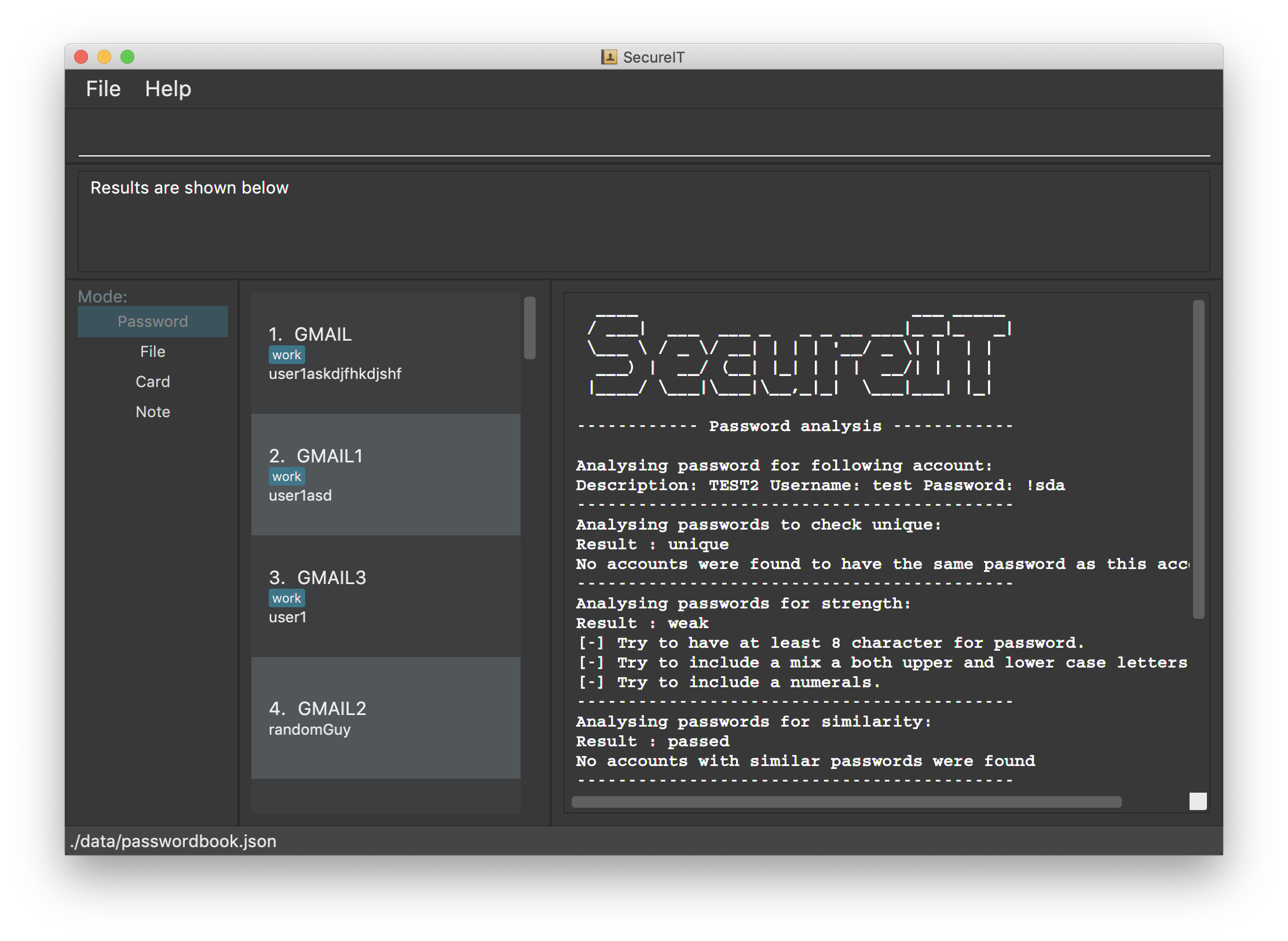
SecureIT operates via a Command-Line Interface(CLI), and executes accordingly to the user inputted commands.
Summary of contributions
This section acts as a summary of my contributions to SecureIT. |
-
Major enhancement: the ability to analyse the level of security of the users' passwords.
-
What it does: The password analysis feature provides the ability to evaluate and subsequently view details about the security level of each of the user’s passwords.
-
Justification: This feature greatly improves the utility of SecureIT because the various analysis tests allows the user to identify different weaknesses in their password and thereby make the necessary corrections to ensure the security of each account.
-
Highlights: It was highly challenging to implement the analysis feature. Some of the key considerations include:
-
Design: The design of the entire analysis component follows that of a Command Pattern. This greatly increases the extensibility of the analysis feature to accommodate even more types of analysis tests in the future.
-
Data structure and algorithms: The implementation of the various analysis tests requires the use of more complex concepts such as recursion and multiple pointers. The implementation also required knowledge on the use of more complex data structures such as TreeMaps and HashMaps in order to help boost the efficiency of the product.
-
-
Credits: [Levenshten-Distance algorithm]
-
-
Major enhancement: the ability to generate random secure passwords.
-
What it does: The password generation feature provides the ability to generate customisable, and truly random passwords.
-
Justification: This feature greatly improves the utility of SecureIT because it alleviates the user of needing to think of a password whenever he needs to create a new account. More importantly, the password provided is guaranteed to be random and thereby secure.
-
Highlights: It was challenging to implement truly random password generation. In-depth research was required on how best to generate truly random passwords. The generation of passwords leverages on the
java.security.SecureRandomAPI for a cryptographically strong random number generator (RNG) to make the password generation as random as possible.
-
-
Code contributed: [Reposense]
-
Other contributions:
-
Team contributions:
-
Project management:
-
Documentation
-
Made cosmetic improvements to the existing User Guide by creating the project logo.
-
-
Contributions to the User Guide
Given below are sections I contributed to the User Guide. They showcase my ability to write documentation targeting end-users. |
Generating a new password: generate
Lazy to think of a strong password?
Simply enter generate into the command box to get one. It’s random, secure and totally hassle-free!
Try it out!
-
Want to customise your password? Don’t worry, we’ve got that covered too. You can customise the following fields during generation:
-
Length of password (Between 4 and 25)
-
Exclusion of lower alphabets
-
Exclusion of upper alphabets
-
Exclusion of numbers
-
Exclusion of special characters
-
-
Refer to usage format below for more details.
| You are only required to indicate for fields you wish to exclude! |
| Please ensure at least one character set is included. |
Format: generate [length/LENGTH] [lower/FALSE] [upper/FALSE] [num/FALSE] [special/FALSE]
Example: generate
Example: generate length/10
Example: generate lower/false special/false
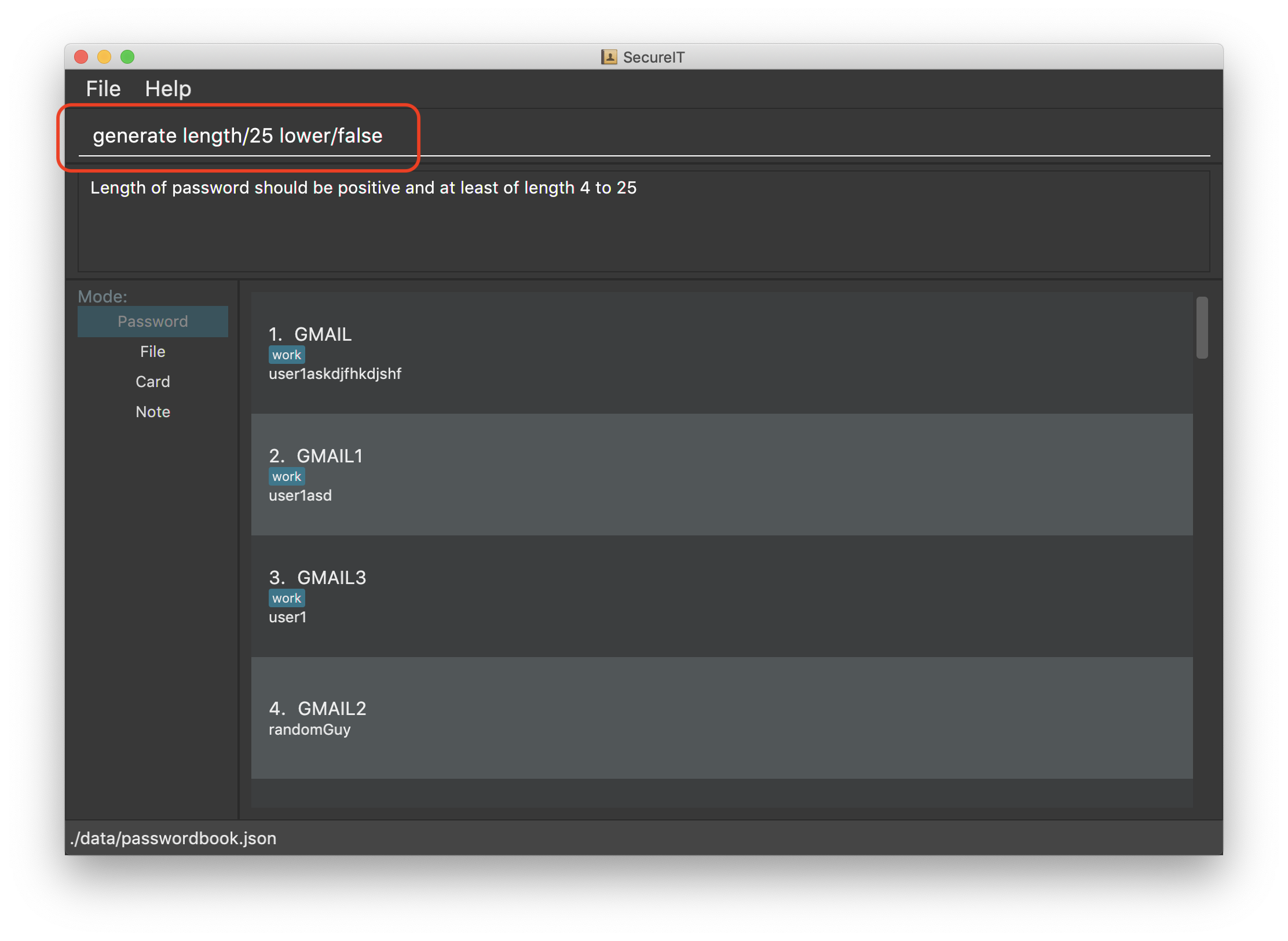
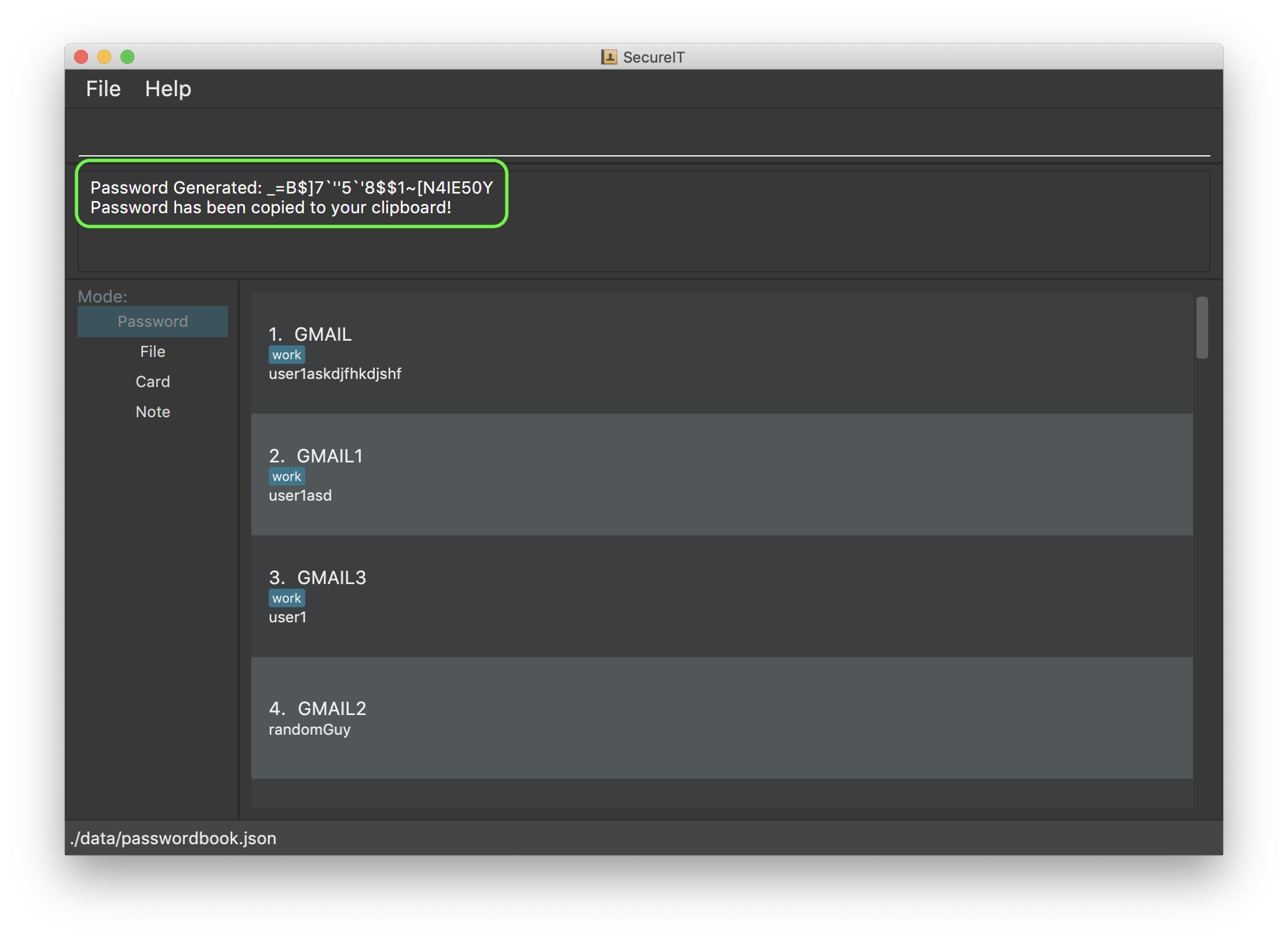
Analysing passwords : analyse
Curious to know how secure your passwords really are? Type analyse into the command box to find out. You might be surprised…
Try it out!
-
You can opt to view:
-
A general, summary security report for all passwords, or
-
A detailed security report for a specific password.
-
-
To view the detailed analysis of a particular password, simply add in the
strongprefix with theINDEX
INDEX used should be that of an existing password.
|
-
Refer to usage format below for more details.
Format: analyse [strong/INDEX]
Example: analyse
Example: analyse strong/8
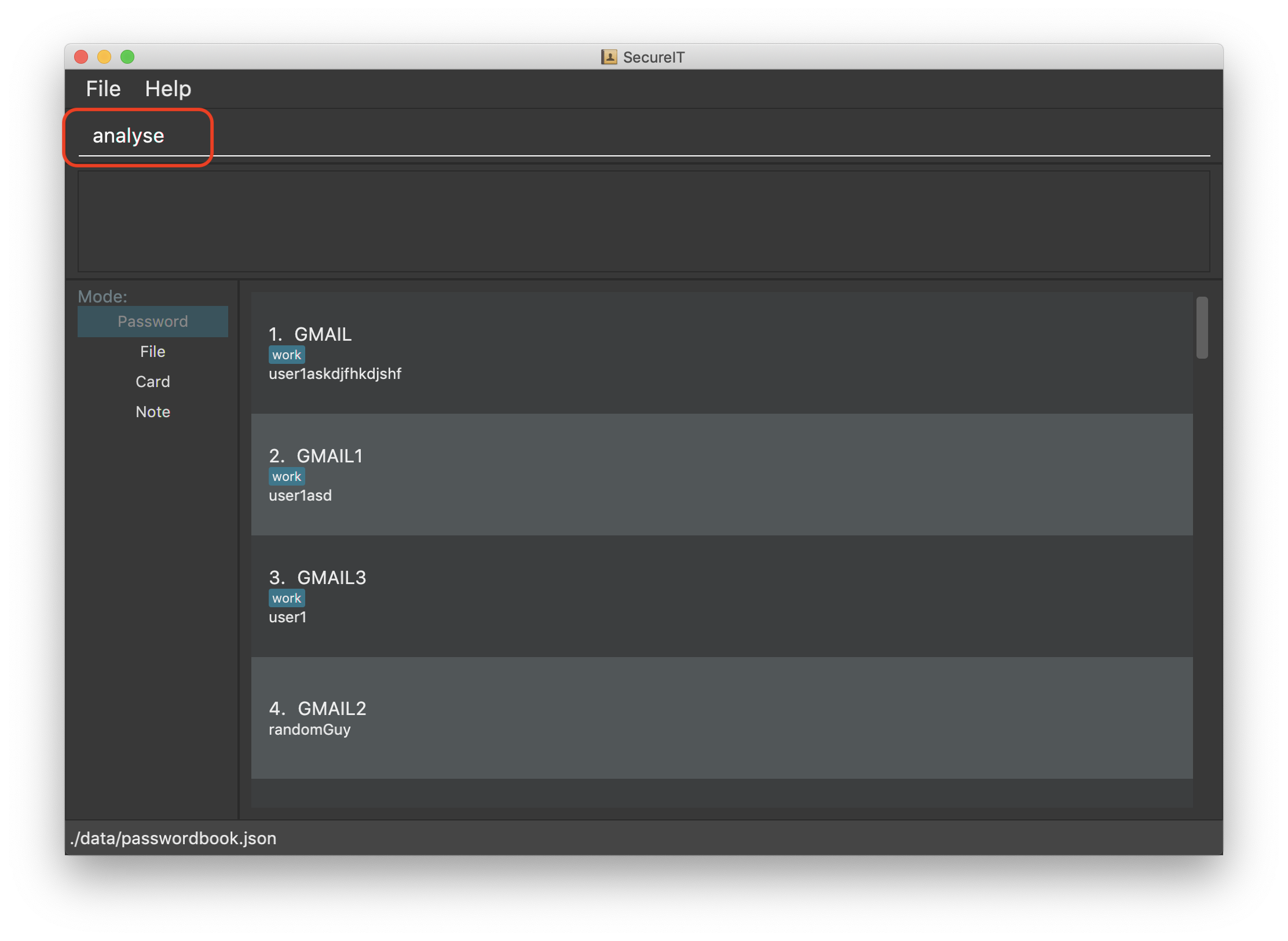
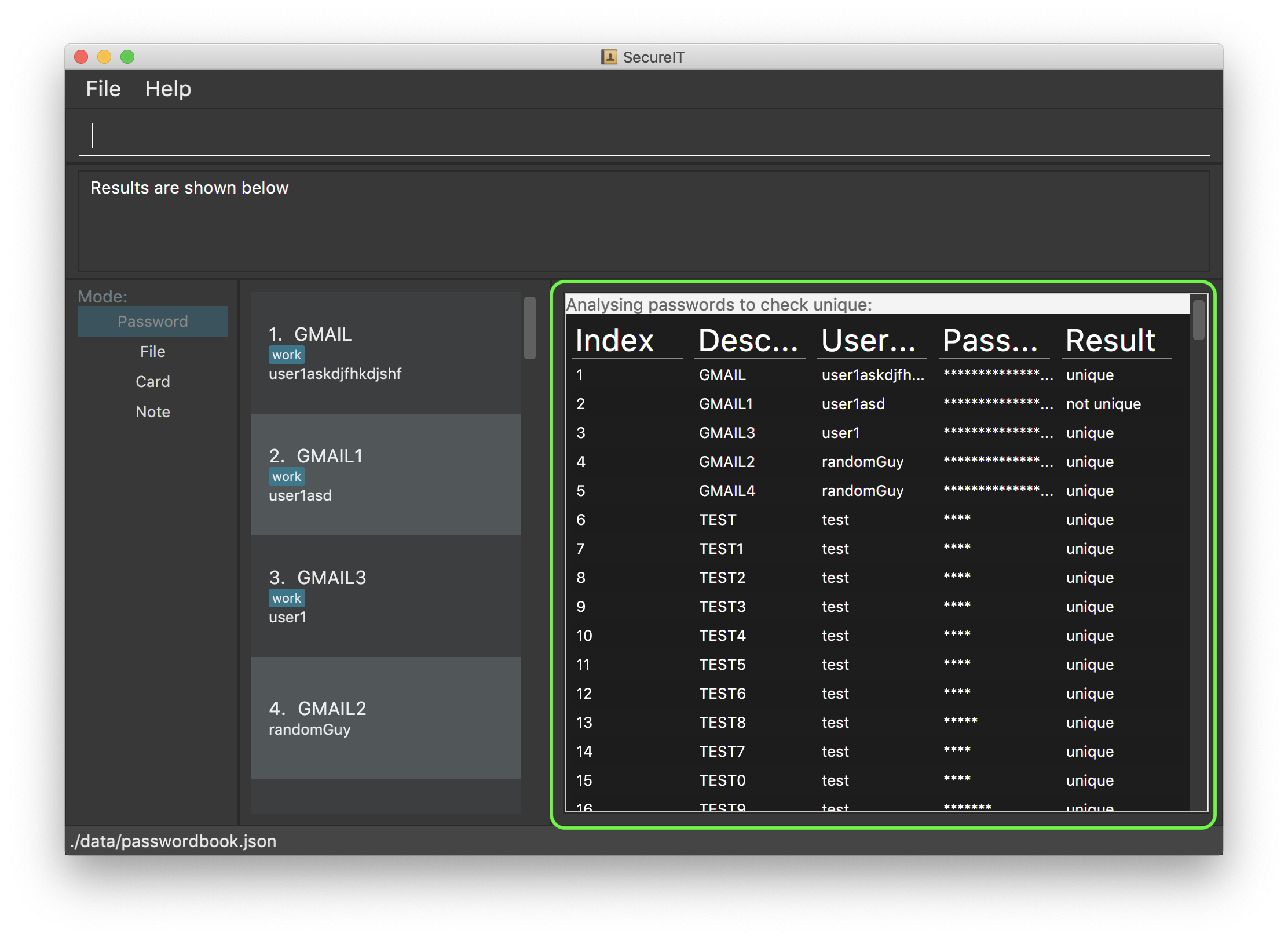
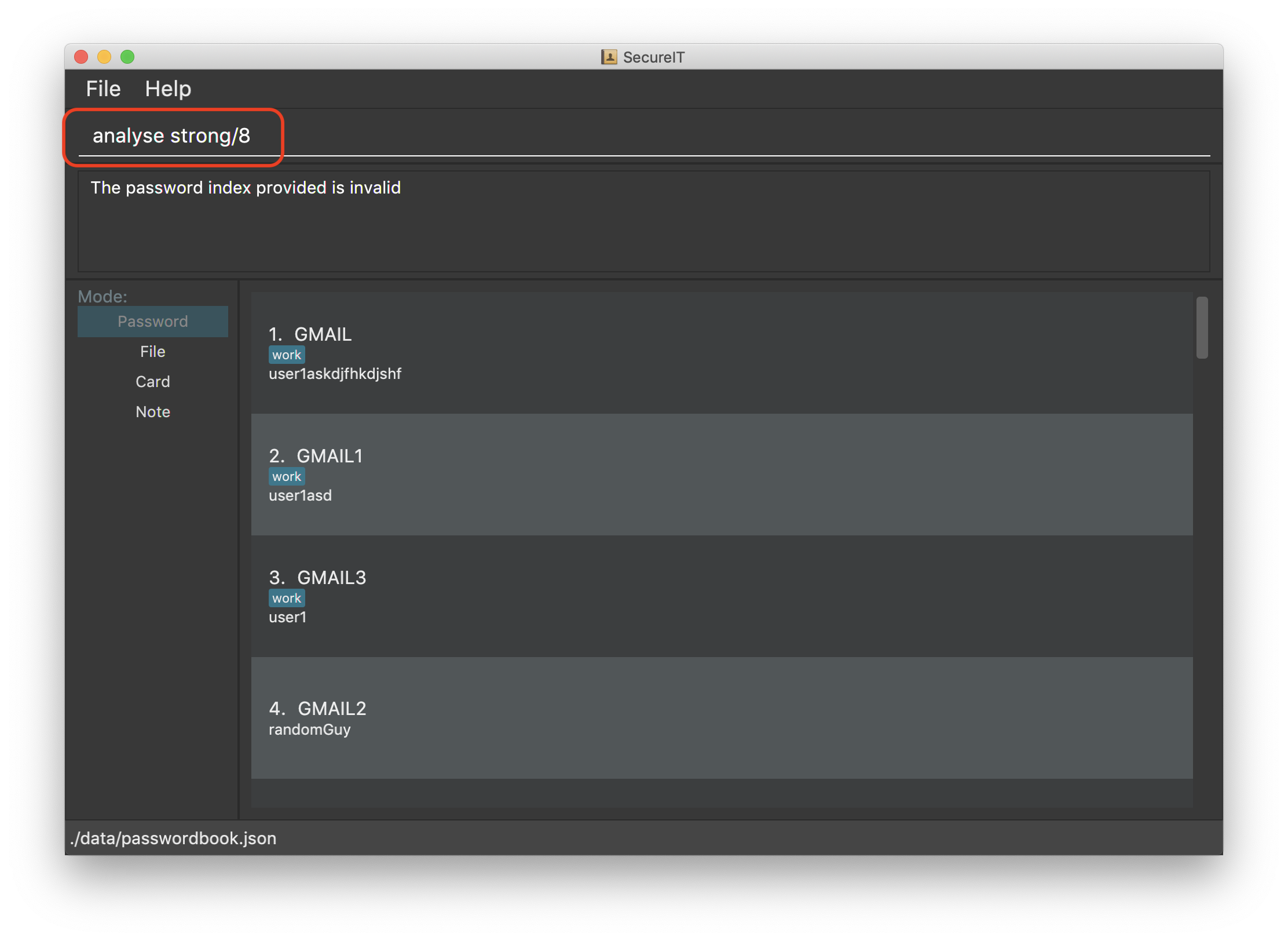
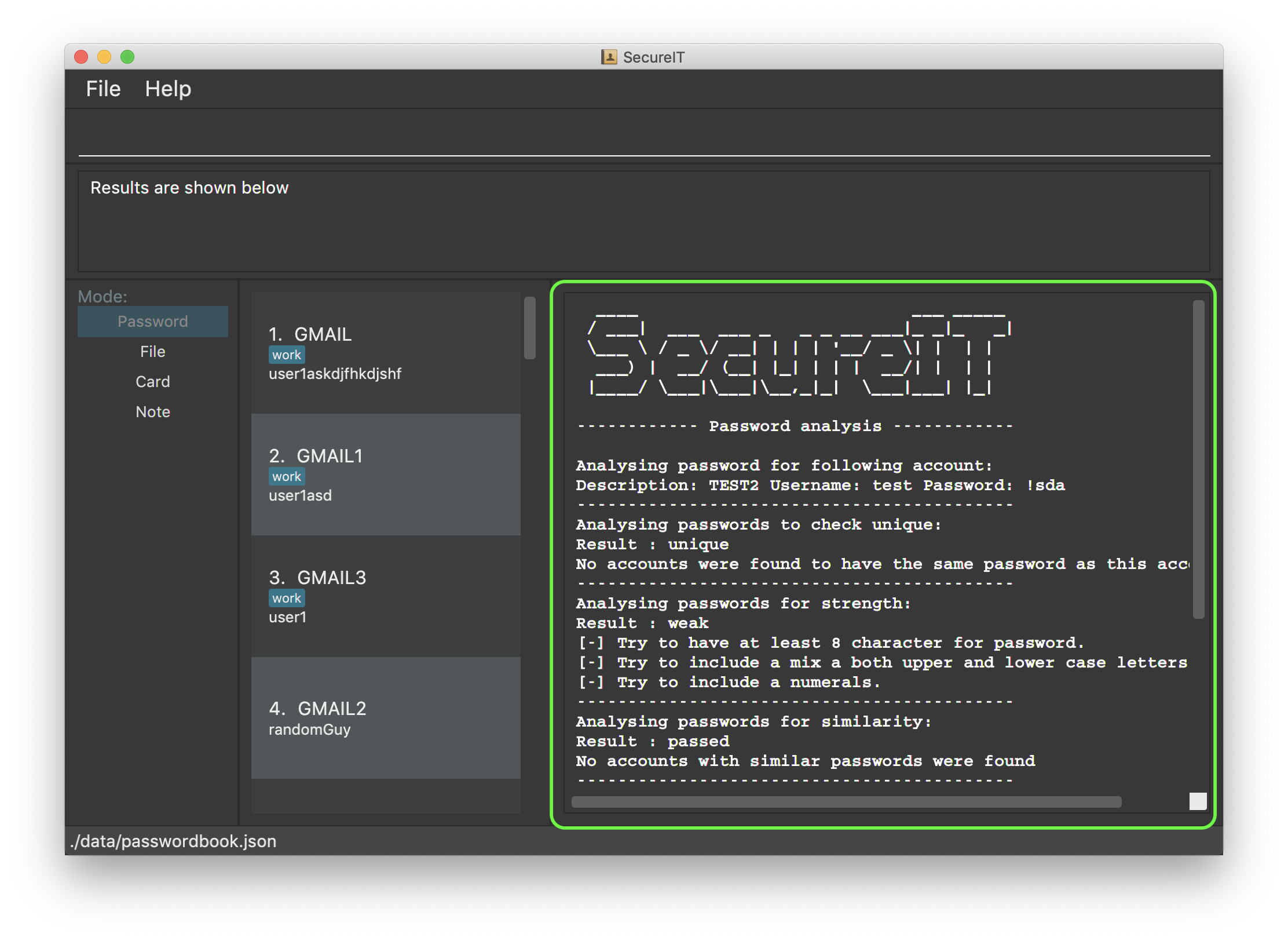
Contributions to the Developer Guide
Given below are sections I contributed to the Developer Guide. They showcase my ability to write technical documentation and the technical depth of my contributions to the project. |
Generate Password
This section provides implementation details on the password generation feature.
Overview
The purpose of password generation is to provide users with a hassle-free way to generate random, secure passwords.
By default, the password generation feature will generate a random password that:
-
is 10 letters long
-
contains lower case alphabets, upper case alphabets, numbers, and special characters.
However, users can alternatively choose to customise any of the aforementioned fields as per their needs through their input.
The generation of truly random passwords is made possible through the use of the java.security.SecureRandom API.
It provides a cryptographically strong random number generator (RNG) that will be used in the password generation.
Implementation
The following activity diagram summarises the general steps taken during password generation:
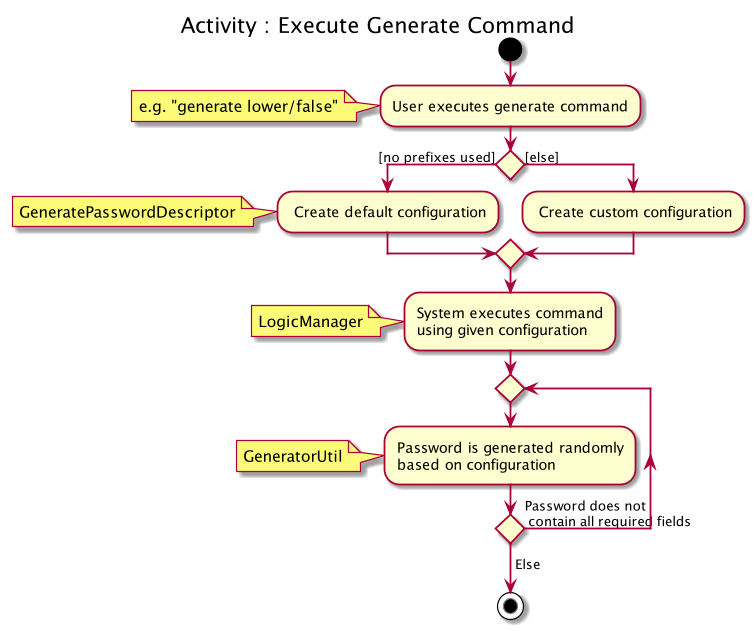
The steps below outline explicity the generation of passwords :
-
The user input is
#parse()by theGeneratePasswordCommandParser. -
Based on the user input, a
GeneratePasswordDescriptoris instantiated.-
If the user input includes optional prefixes to customise configuration, we modify the attributes of the
GeneratePasswordDescriptorthrough various setter methods. -
Else, the default
GeneratePasswordDescriptoris instantiated through the static methodGeneratePasswordDescriptor#getDefaultConfiguration().
-
The GeneratePasswordDescriptor is an object that encapsulates the settings of the configuration used for password generation.
|
-
The
GeneratePasswordCommandis then instantiated with the given configuration. -
Upon
GeneratePasswordCommand#execute(), the static methodGeneratorUtil#generateRandomPassword()is invoked:-
Based on the configuration, the relevant character sets (lower-case alphabets, upper case alphabets, numerals, special characters) are added into a list.
-
The
GeneratorUtilclass uses the methodjava.security.SecureRandom.nextInt()to choose a random characters set, followed by a random character within that set to be included in the new password. -
This process of choosing a character to include in the password is repeated for the length of the password.
-
-
The generated password is then checked to see if it includes all the user requirements (ie. whether it includes all the character sets specified by the user.)
-
This process of generating a password is repeated until the user requirements are met.
The activity diagram below depicts the way in which a password is generated by the method GeneratorUtil#generateRandomPassword():
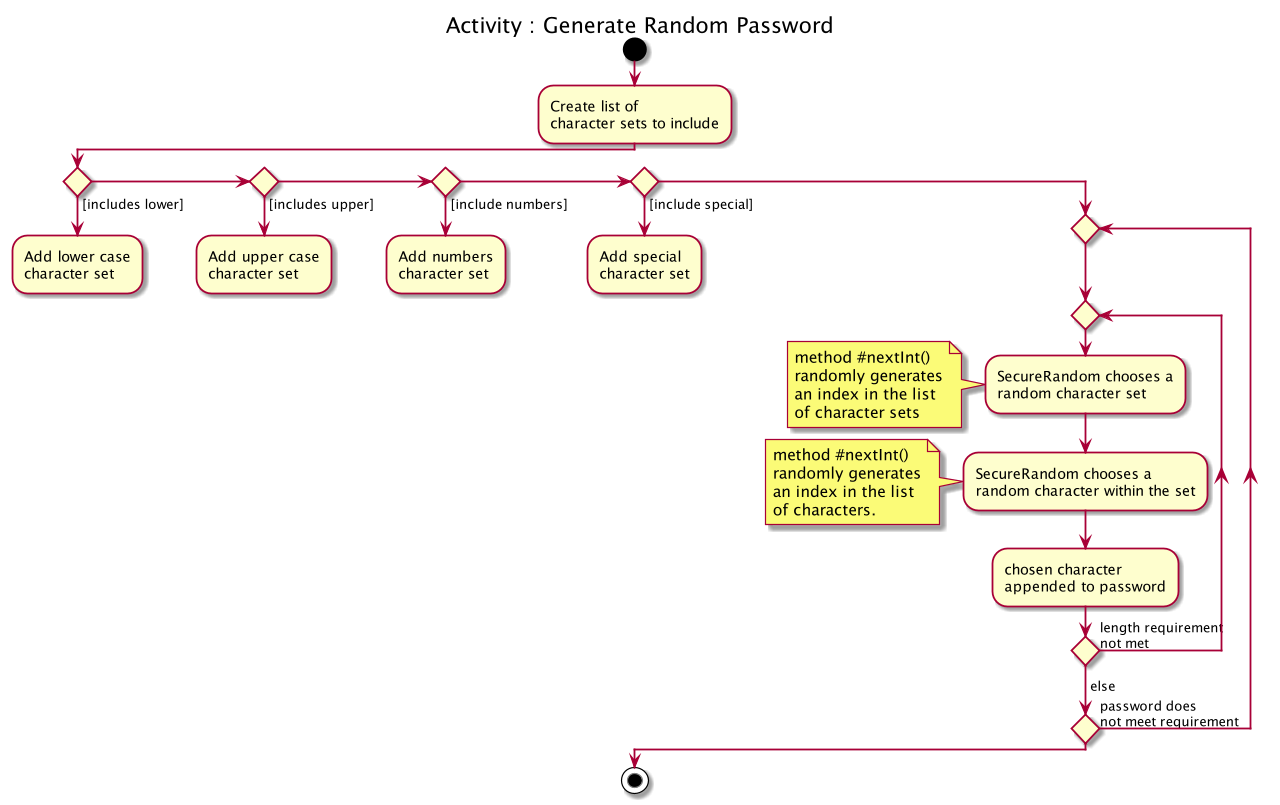
Design considerations
These are the considerations we came across when implementing the generate feature:
Aspect: How to generate a random password
Alternative 1 (Current choice) |
Alternative 2 How to generate a truly random password |
Randomly choose a character set, followed by a character within the set to include in password: |
Ensuring all user configurations are met by hard coding a pattern in the way character sets are included |
Why did we choose Alternative 1: |
|
Analyse Password
This section provides implementation details on the analyse password feature.
Overview
The purpose of analysing passwords is to provide users with information on the level of security of their passwords.
The user can either :
-
View a summary table of results of all password by inputting
"analyse"OR -
View a detailed review of a specific password by inputting
"analyse strong/INDEX"
SecureIT analyses 6 core components of every Password, using various Analysers. The following table summarises the functionality of each Analyser:
Analyser: |
Purpose: |
UniqueAnalyser |
Checks that every password is unique. |
StrengthAnalyser |
Checks the complexity of every password. |
SimilarityAnalyser |
Checks that no two accounts share a password that is at least 70% similar. |
DictionaryAnalyser |
Checks that password does not contain any commonly-used passwords. (e.g. "password") |
SequenceAnalyser |
Checks that password does not contain any commonly-used sequences. (e.g. "ABC") |
KeyboardAnalyser |
Checks that password does not contain any commonly-used keyboard patterns. (e.g. "qwerty") |
The following class diagram is the current structure of the Analyser component.
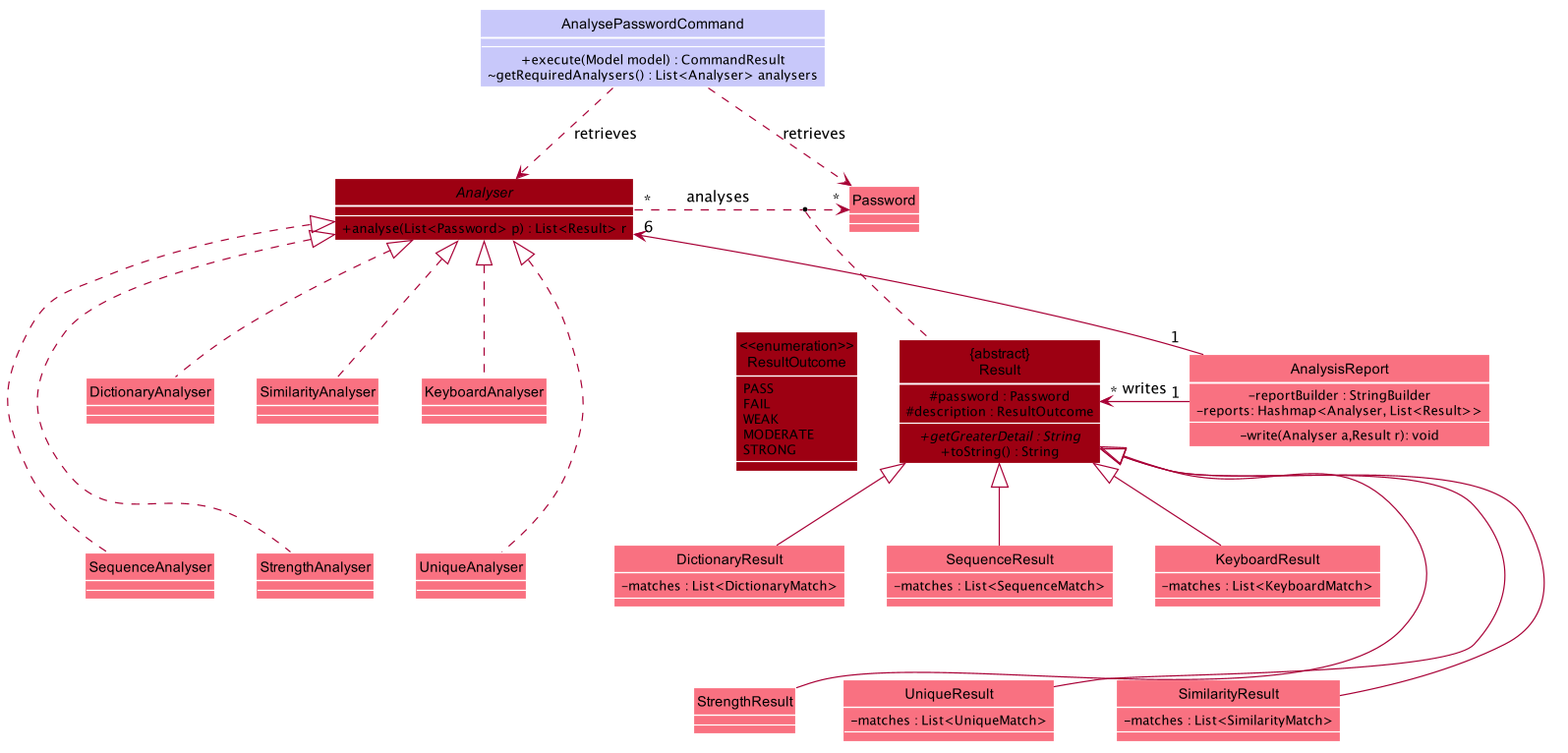
In summary,
-
The analysis of passwords is initiated upon
#execute()of theAnalysePasswordCommand. -
Each
Analyseranalyses every password in the password book. -
The analysis of each password produces the respective
Resultfor that password. -
These
Resultsare compiled and written into aAnalysisReport, which is then shown to the user in the form of a summary table. -
Users can opt to view a detailed report for a specific password to get more information on the respective
Result.
Implementation
On #execute(), AnalysePasswordCommand retrieves the current list of passwords via Model#getFilteredPasswordList().
It also retrieves the required analysers via #getRequiredAnalysers().
Each Analyser has it’s own implementation of #analyse(), which will subsequently be invoked by the AnalysePasswordCommand given the current list of passwords.
The following sequence diagram breaks down the general flows of events stated above, and in the context of a DictionaryAnalyser:
For the following sequence diagram, the other Analysers are instantiated in a similar fashion in #getRequiredAnalsyers() and hence omitted to the make the diagram less congested.
|
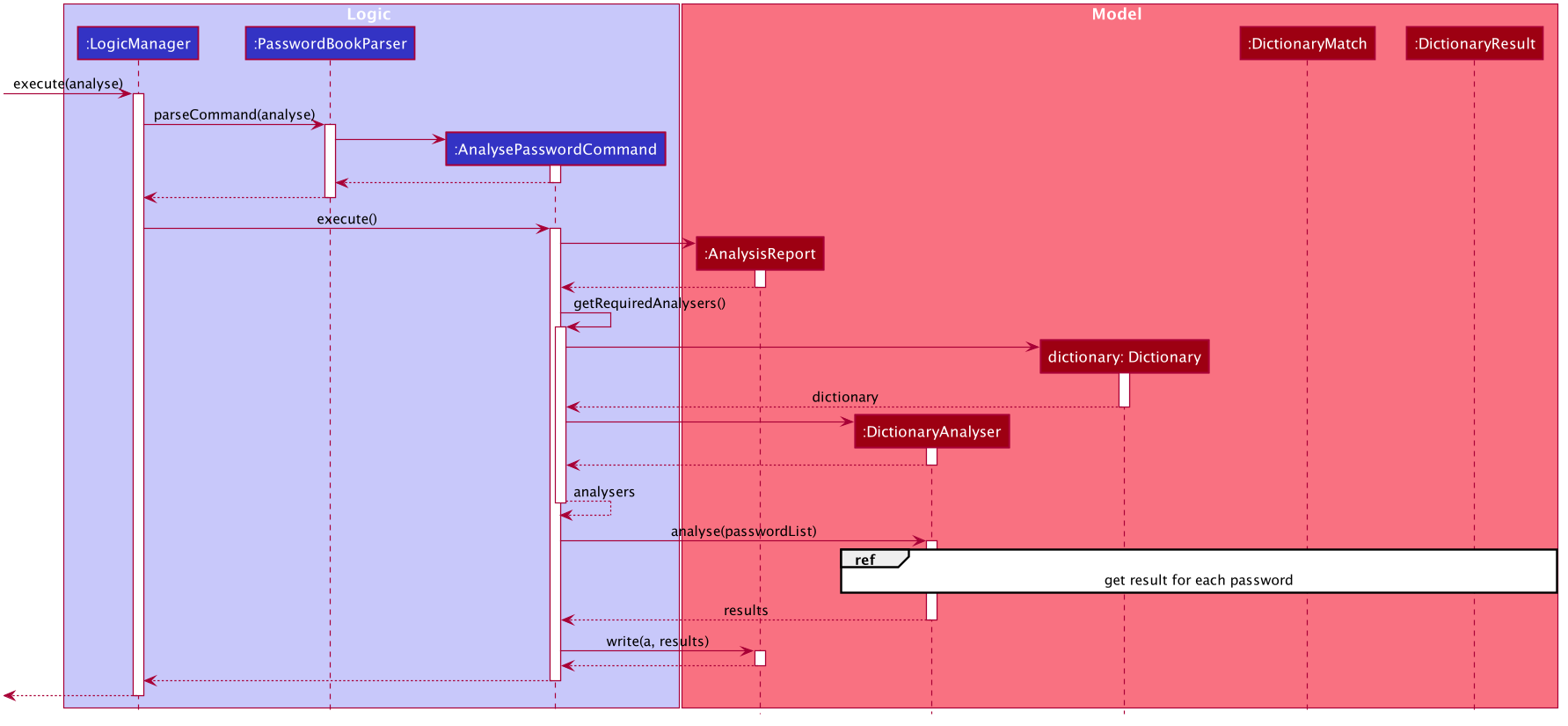
In the following discussion, we will be reviewing how Results are produced for each password, in the context of the DictionaryAnalyser.
In the case of the DictionaryAnalyser#analyse(), every password is checked to see if it contains any subsequence that is listed as a commonly used password in the instantiated Dictionary. This is done in the internal method #getAllMatches() within #analyse().
The Dictionary is an object that maps commonly used passwords to their ranking in terms of how commonly used they are. (e.g. "123456" is mapped to rank 1 in the Dictionary because it is the most commonly used password)
|
If there exists a subsequence that tests positive when looked up against the Dictionary , a DictionaryMatch is created to note down the details of the subsequence.
As long as a DictionaryMatch is found, then the password has failed the analysis. A DictionaryResult with the attribute ResultOutcome.FAIL will be created for that password. This process is repeated for every password. Following, the list of DictionaryResult are returned to be compiled and written by the AnalysisReport.
It is also worth mentioning that DictionaryAnalyser is capable of identifying commonly used passwords even in leet-ed variations (e.g. p@5sw0rd).
This is made possible because of the method #LeetUtil.translateLeet(), which is a recursive algorithm designed to return all possible un-leet variations, given a leet-ed password.
The following sequence diagram depicts the flow of events mentioned above:

Design Considerations
Aspect: How analyse/analyse strong executes
| Alternative 1 (Current choice) | Alternative 2 |
|---|---|
Always analyse the entire list of Password objects for every "analyse" command,
even if the list of Passwords was unchanged. |
Save in memory the result produced by the Analyser objects, and update result upon modification of
list of Passwords. |
Why did we choose Alternative 1: |
|
